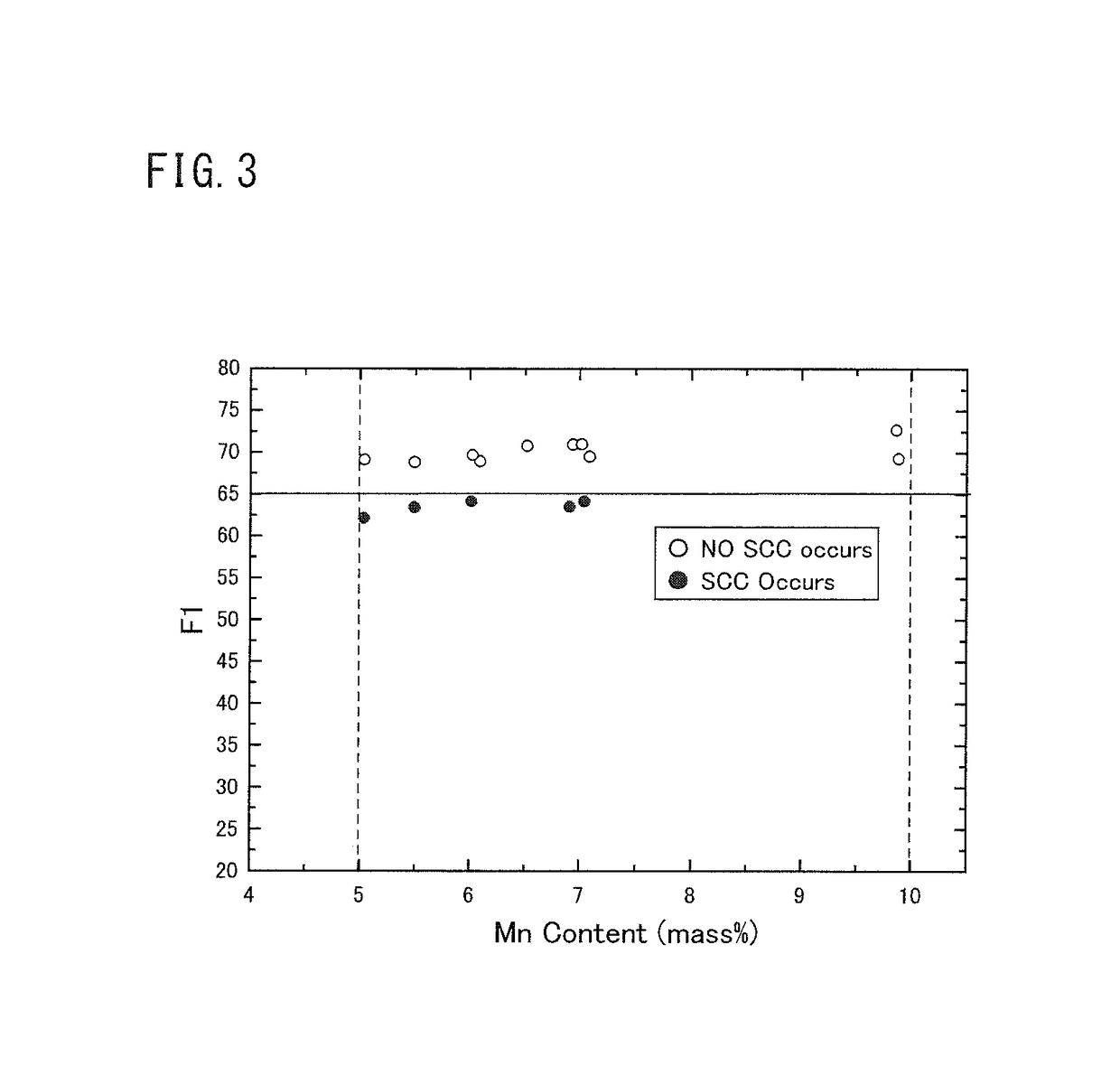Duplex stainless steel
a technology of stainless steel and duplex, which is applied in the field of stainless steel, can solve the problems of achieve the effects of suppressing precipitation, high content, and reducing the toughness and corrosion resistance of duplex stainless steel
- Summary
- Abstract
- Description
- Claims
- Application Information
AI Technical Summary
Benefits of technology
Problems solved by technology
Method used
Image
Examples
example 1
[0085]Duplex stainless steel plates including multiple kinds of chemical compositions were produced, and evaluations of the yield strength and the σ phase susceptibility were conducted on each produced duplex stainless steel plate.
[0086][Test Method]
[0087]Each molten steel of the marks A to K having each chemical composition shown in Table 1 was produced using the vacuum furnace. An ingot was produced from each produced motel steel. The weight of each ingot was 150 kg.
[0088]
TABLE 1Chemical Composition (Unit: Mass %, Balance: Fe and Impurities)CategoryMarkCSiMnPSNisol. AlNCrMoCuWVCaMgBF1InventiveA0.0180.495.040.0150.00095.060.0150.22525.091.002.480.100.110.0040—0.001869.1ExampleB0.0180.505.500.0150.00105.060.0150.22424.901.002.460.100.110.0040—0.001868.9SteelC0.0180.496.100.0150.00105.060.0150.21225.011.002.460.100.110.0040—0.001869.0D0.0160.507.090.0170.00125.110.0150.23025.051.012.470.100.110.0042—0.002169.5E0.0170.489.880.0140.00105.080.0110.22625.110.972.480.090.080.0038—0.001669...
example 2
[0102]A welded joint was produced using each specimen steel plate of the marks C and D, and the marks I and J, and the σ phase susceptibility was evaluated for each welded joint.
[Test Method]
[0103]Four plate materials 10 shown in FIG. 4A and FIG. 4B were produced from each specimen steel plate of the marks C, D, I, and J. FIG. 4A is a plan view of each plate material 10, and FIG. 4B is a front view of each plate material 10. In FIG. 4A and FIG. 4B, each numerical value to which “mm” is attached denotes a dimension (unit: mm).
[0104]As shown in FIG. 4A, and FIG. 4B, each plate material 10 had a thickness of 12 mm, a width of 100 mm, and a length of 200 mm. The plate material 10 had a V-type groove face 11 whose groove angle was 30° at the longer side. Each plate material 10 was produced through machining.
[0105]Two of the produced plate materials 10 were disposed such that the V-type groove surface 11 of one plate material 10 opposed that of the other plate material 10. The two plate m...
example 3
[0114]As similar to Example 1, multiple duplex stainless steel plates having multiple types of chemical compositions were produced. The yield strength, the existence of the σ phase, the SSC resistance, and the SCC resistance were evaluated for each of the produced duplex stainless steel plates.
[Test Method]
[0115]Each molten steel of the marks A to L, the marks M to Z, and the marks AA to AC having each chemical composition shown in Table 5 was produced using a vacuum furnace. An ingot was produced from each molten steel. The mass of each ingot was 150 kg.
[0116]
TABLE 5Chemical Composition (Unit: Mass %, Balance: Fe and Impurities)sol.CategoryMarkCSiMnPSNiAlNCrMoCuWVCaMgBF1InventiveA0.0180.495.040.0150.00095.060.0150.22525.091.002.480.100.110.0040—0.001869.1ExampleB0.0180.505.500.0150.00105.060.0150.22424.901.002.460.100.110.0040—0.001868.9SteelC0.0180.496.100.0150.00105.060.0150.21225.011.002.460.100.110.0040—0.001869.0D0.0160.507.090.0170.00125.110.0150.23025.051.012.470.100.110.004...
PUM
| Property | Measurement | Unit |
|---|---|---|
| yield strength | aaaaa | aaaaa |
| temperature | aaaaa | aaaaa |
| temperature | aaaaa | aaaaa |
Abstract
Description
Claims
Application Information
 Login to View More
Login to View More - R&D
- Intellectual Property
- Life Sciences
- Materials
- Tech Scout
- Unparalleled Data Quality
- Higher Quality Content
- 60% Fewer Hallucinations
Browse by: Latest US Patents, China's latest patents, Technical Efficacy Thesaurus, Application Domain, Technology Topic, Popular Technical Reports.
© 2025 PatSnap. All rights reserved.Legal|Privacy policy|Modern Slavery Act Transparency Statement|Sitemap|About US| Contact US: help@patsnap.com



